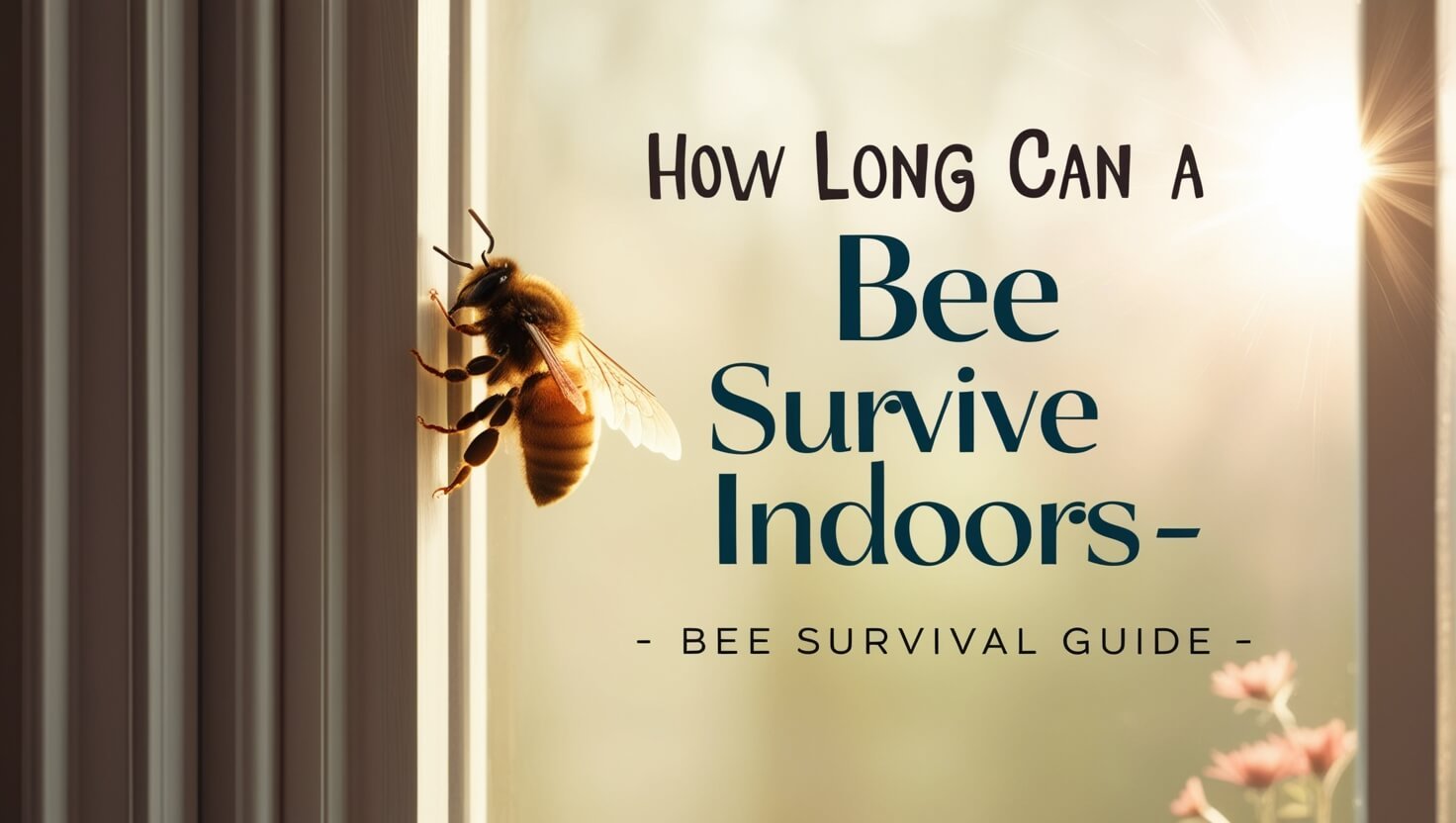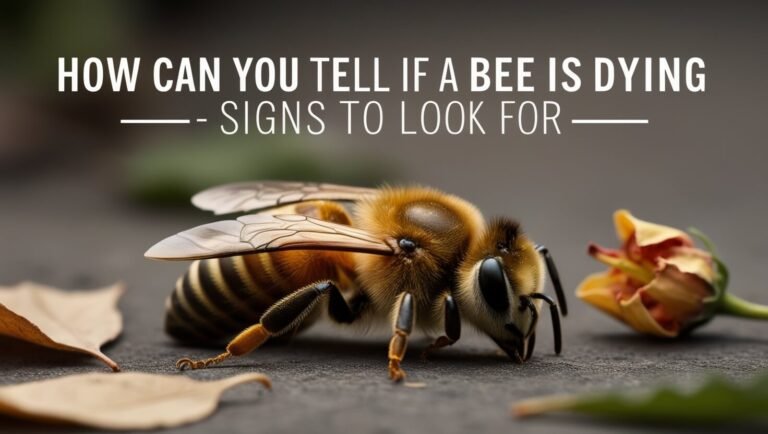How Long Can a Bee Survive Indoors – Bee Survival Guide

Bees are amazing pollinators in our world. But what if they end up inside unexpectedly? How long can they survive in this new place? Let’s explore the world of bee biology and behavior to find out.
The Natural Habitat of Bees and Indoor Challenges
Bees are amazing creatures that live in the outdoors. They build complex hives and nests in colonies. But, when they come inside, they face many challenges.
Impact of Indoor Environment on Bee Behavior
Indoors, bees struggle to find food and get lost. Without their usual food, they can’t navigate well. They also miss their colony’s cues, affecting their communication and hive temperature.
Common Reasons Bees Enter Homes
Bees might enter homes through small openings or seek shelter. Swarming, when a colony splits, can also bring bees inside.
Indoor Temperature and Humidity Effects
Home temperatures and humidity affect bees greatly. They need specific conditions to survive. Changes can harm their hive and colony.
“Honey bee colonies, once established in wall cavities or voids, can live for a long time, even years, if undisturbed.”
Understanding bees’ outdoor lives and indoor struggles helps us appreciate them more. Knowing why they enter homes and how indoor conditions affect them is crucial. It helps us manage bees better and protect their habitats.
Types of Bees Found Inside Homes
Bees that get into homes are usually honey bees, bumble bees, carpenter bees, or solitary bees. Knowing which type you have helps figure out how to get rid of them.
Honey Bees are small with brown and yellow bands on their belly. They are key to pollination and making honey. Honey bee colonies can live in walls for years if they have food and water nearby.
Bumble Bees are bigger and fuzzy, with black and yellow stripes. They like to nest in walls or other man-made places. The queen bee starts new colonies every year.
Carpenter Bees look like bumble bees but have shiny black bodies with yellow stripes. They drill into wood to make nests, which can harm the structure of your home.
Solitary Bees come in many shapes and don’t live in groups like honey bees or bumble bees. They look for places to nest in homes.
Knowing what kind of bee you have is key to removing them right. This helps avoid more problems and damage to your home.
| Bee Type | Appearance | Nesting Behavior | Potential Risks |
|---|---|---|---|
| Honey Bees | Small, brown and yellow bands | Can survive for years in wall voids with access to food and water | Swarming, stinging |
| Bumble Bees | Larger, fuzzy, black and yellow stripes | Establish new colonies yearly in cavity walls or human-made structures | Aggressive when disturbed, stinging |
| Carpenter Bees | Resemble bumble bees, with shiny black/yellow abdomens | Bore into wood structures to create nesting sites | Structural damage, stinging |
| Solitary Bees | Diverse appearance, do not form social colonies | Search for nesting sites in various areas of the home | Less aggressive, but can sting if threatened |
The best time to get rid of bees is in late winter or early spring. This is when there are fewer bees because it’s cooler. It’s better to remove them alive to help the environment. Always get help from experts for safe bee removal.
How Long Can a Bee Survive Indoors
The lifespan of a bee can change a lot, both outside and inside. Bees are usually tough, but surviving indoors is hard without their natural food and water.
Factors Affecting Indoor Survival Time
Many things can affect how long a bee lives indoors. These include the bee’s type, food and water availability, and the indoor environment. Bee lifespan indoors can be from hours to days, based on these factors.
Access to Food and Water
Bees need nectar and pollen to live. Bee survival factors like having these foods are key. Without them, bees inside can die in a day or two.
Environmental Stress Factors
The indoor world can harm a bee’s health and life. Without natural light, not being able to go back to the hive, and harmful substances can stress bees. This can make their life shorter inside.
| Bee Lifespan | Outdoor Environment | Indoor Environment |
|---|---|---|
| Worker Bees | 5-6 weeks (summer) | 1-2 days without food/water |
| Queen Bees | Up to 5 years | Likely to survive longer than workers |
| Drones | A few months | Unlikely to survive more than a few days |
In summary, bees live much shorter lives indoors than outside. Most die in a day or two without food and water and facing indoor stress. Understanding bee survival factors is key to helping them survive inside homes or other indoor places.
Signs of Trapped Bees in Your Home
Spotting signs of trapped bees in your home is key to catching problems early. By watching for these signs, you help both the bees and your family stay safe.
One clear sign is the buzzing sound bees make. If you hear buzzing in places you don’t expect, bees might be inside. They also tend to gather near windows or lights, which they find attractive.
Seeing bees that seem slow or lost is another sign. Without food and in a strange place, they can look tired and confused. Spotting these behaviors early can help you catch a bee problem before it gets worse.
Bees can sneak into your home through many spots, like fireplaces, attic vents, or gaps in walls. Watching for bee activity around these areas can help you find where they’re coming from. This way, you can take steps to stop them.
| Potential Entry Points for Bees | Indicators of Bee Presence |
|---|---|
| Fireplace openings | Bees gravitating towards windows |
| Attic vent holes | Observed flight activity around vents |
| Gaps under eaves | Bees entering through small spaces |
| Cracks in walls | Bee activity near gas pipes or rain gutters |
Finding trapped bees early is important for everyone’s safety. By being alert and acting fast, you can solve the problem safely and effectively.
Indoor Bee Behavior Patterns
When bees get trapped indoors, they show special behaviors. These patterns help us understand how to safely help them. Knowing where and how they move is key to assisting these bees.
Flying and Movement Patterns
Indoors, bees fly erratically as they try to find their way. They might hit windows or go to light sources. This shows how tricky it can be to follow their paths.
Common Areas Where Bees Gather
- Windowsills: Bees like windowsills for the light and a chance to get in or out.
- Light Fixtures: The warmth and light of indoor lights attract bees, who might nest or gather there.
- Sweet Scents: Bees love sweet smells, like spills or food areas, which draw them in.
Knowing where bees gather helps us find and safely remove them. This keeps both the bees and homeowners safe.
Safe Methods for Bee Removal
Dealing with bees in your home requires care for both your safety and theirs. Luckily, there are humane ways to remove them without harm.
One easy method is to open windows and doors. This lets the bees leave and go back to their natural place. You can also use a cup or bowl to catch and release them safely outside.
For bigger problems or hives, you might need a different plan. A sugar water trap can draw bees out and guide them to a safe exit. This method is kind to bees and works well for homeowners.
While DIY methods work for many cases, sometimes you need a pro. Experts can handle big bee problems safely. They make sure everyone stays safe and the bees are okay.
Remember, humane bee removal and DIY bee removal techniques focus on safety for all. Using gentle methods helps solve bee problems without harming these important pollinators.
Prevention Strategies for Bee Entry
Keeping your home safe from bees is important for your safety and theirs. By using good bee prevention methods, you can live in harmony with these important pollinators.
Sealing Entry Points
Sealing off entry points is a key step in keeping bees out. Look for cracks, gaps, or openings bigger than 3/16 inches. Bees can fit into tiny spaces. Use materials like 1/8-inch galvanized metal screens or silicone sealants to block these spots.
Natural Deterrents
Using natural deterrents can also help keep bees away. Peppermint oil or vinegar solutions can make areas around your home unappealing to bees. Regular checks and maintenance can help find and fix bee attractants or entry points early.
By using these bee prevention methods and bee-proofing homes, you can lower the chance of bees entering your home. This keeps your family safe and shows respect for the role bees play in our world.
Risks of Prolonged Bee Presence Indoors
Having bees indoors might seem like a small problem. But, the dangers of having them around for too long are real. Health risks from bee stings are a big concern, especially for those with allergies. Bees can also make hives in walls or attics, causing expensive damage.
Dead bees can attract other pests like ants or rodents. This makes the problem worse and creates more cleaning issues. Also, keeping bees indoors for too long harms them and hurts their natural environment. This can help explain why bee numbers are falling.
It’s important to get bees out of your home quickly and safely. Trying to deal with them yourself can make things worse. That’s why getting help from a pest control expert is key to solving the problem.
Best Questions:
How long can a bee survive indoors?
Bees usually survive about 1 day indoors without food or pollen. Their survival time depends on their species, food availability, and the environment.
What are the challenges bees face when living indoors?
Indoor environments are tough for bees. They lack food and face different temperatures and humidity. This affects their ability to find food and navigate.
What are the common types of bees found inside homes?
You might find honey bees, bumble bees, carpenter bees, and solitary bees indoors. Knowing the type is key for safe removal.
What factors affect a bee’s ability to survive indoors?
Bees need food and water to survive indoors. Environmental stressors like lack of light and exposure to harmful substances also play a role.
How can I tell if there are bees trapped inside my home?
Look for buzzing sounds and bees near windows or lights. They might seem disoriented or sluggish without food.
How do bees typically behave when trapped indoors?
Trapped bees fly erratically as they try to find their way. They might bump into windows or gather near sweet smells.
What are some safe ways to remove bees from my home?
Open windows or doors to let them out. Use a cup or bowl to trap and release them. For big infestations, call a professional.
How can I prevent bees from entering my home?
Seal cracks and gaps around windows and doors. Use peppermint oil or vinegar to deter them. Regular checks can help keep your home bee-free.
What are the risks of having bees inside my home for an extended period?
Bees inside for too long can be dangerous, especially for those allergic. They might make hives, damaging your home. Dead bees attract pests. It’s bad for bees and the environment.




